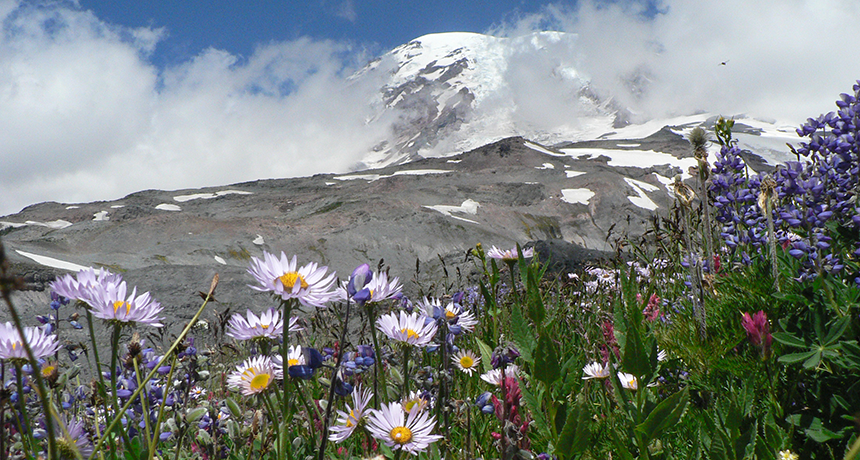Photographing wildflowers and other ways you can help fight climate change
Even nonscientists can take part in climate and conservation research

With the help of volunteers, scientists are monitoring wildflowers on Mount Rainier as part of climate change research.
Mount Rainier National Park/Flickr (CC BY 2.0)
Climate change can seem like a problem too big for any one person to bother tackling. But that doesn’t mean that people are just sitting on the sidelines waiting for the inevitable. There are kids who have sued the U.S. government. More than a million students and other people worldwide took to the streets in a one-day strike on behalf of the climate. And scientists, of course, do research to help inform the public about what’s happening to the world around us.
Many of those scientists could use some help. And sometimes they don’t need scientific experts. Average citizens can supply what they need. Experts refer to these helpers as citizen scientists.
“There [are] really great volunteer programs,” says Janneke Hille Ris Lambers. She’s an ecologist at the University of Washington in Seattle. And she runs one of these many projects. Called MeadoWatch, it focuses on a phenomenon called phenology (Feh-NOLL-uh-gee). This term refers to the fact that the timing of many life events, such as when flowers bloom, is seasonal. Scientists want to know if that timing is changing as the planet warms.
But research into other, non-climate-related areas of conservation also can help, says Hille Ris Lambers. That’s because climate change often isn’t the only type of stress that organisms have to deal with. There are other factors, ranging from the illegal wildlife trade to overfishing and pollution. If scientists can figure out how to eliminate those other factors, then species should have a better chance of being able to deal with climate change.
Scistarter and Zooniverse are two websites that list citizen-science projects in which you can take part. An internet search for “citizen science” and your city, state or country can also bring up local projects that may be seeking volunteers. Here’s a sampling of what such projects might involve:
MeadoWatch
This project, out of the University of Washington, is looking at how climate change is affecting wildflowers on Mount Rainier. Volunteers collect data along hiking trails about when wildflowers bud, flower, fruit and produce seed. The project is also collecting photos of wildflowers from across Mount Rainier National Park.
Great Backyard Bird Count
For four days every February, volunteers around the world count birds in 15-minute sprints. These observations can be made anywhere, including your own backyard. The counts provide scientists snapshots of data on where birds are found, and how many there are. Since the count has been going on for more than 20 years, researchers can now answer questions about how these patterns may be changing with time. That includes how diseases and climate change may be affecting these populations.
Weather Rescue
People have collected weather data for a very long time. And many of these early weather records still exist. But for scientists to use them, data from handwritten, paper records need to be digitized — entered into a computer. This is usually not something that a computer can do well on its own. With Weather Rescue, British researchers are using online volunteers to transcribe daily measurements that were taken in Europe starting in the 1860s. That was before temperatures began to rise because of global warming. These data will provide a useful baseline for future research.
Water Monitoring in Minnesota
Residents of Minnesota can sign up to be a volunteer water monitor for the Minnesota Pollution Control Agency. Volunteers are assigned a lake or stream. Twice a month during the summer, they take measurements of water clarity. Those data let the government see whether water clarity has been changing over time as well as assess the health of those waterways.
Redmap
Gretta Pecl is a marine ecologist in Australia at the University of Tasmania in Hobart. She studies where marine species are moving in response to climate change. She set up a program called Redmap. It asks people to report “uncommon” marine species that they’ve seen in Australian waters. “We wanted to have an early indication of what species were moving where they live,” she explains. But the program also helps when she is talking to the public about climate change. “I think it’s a more powerful conversation, if you can start off from the point of view of what other people are bringing to the table.”







